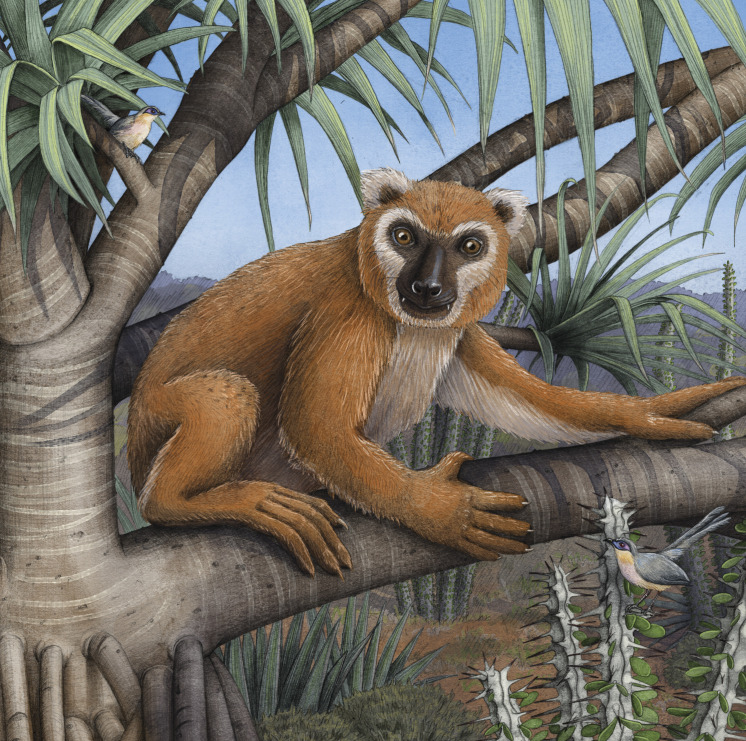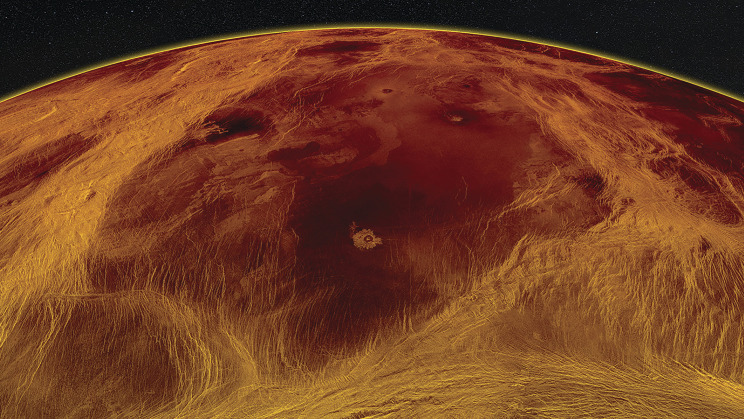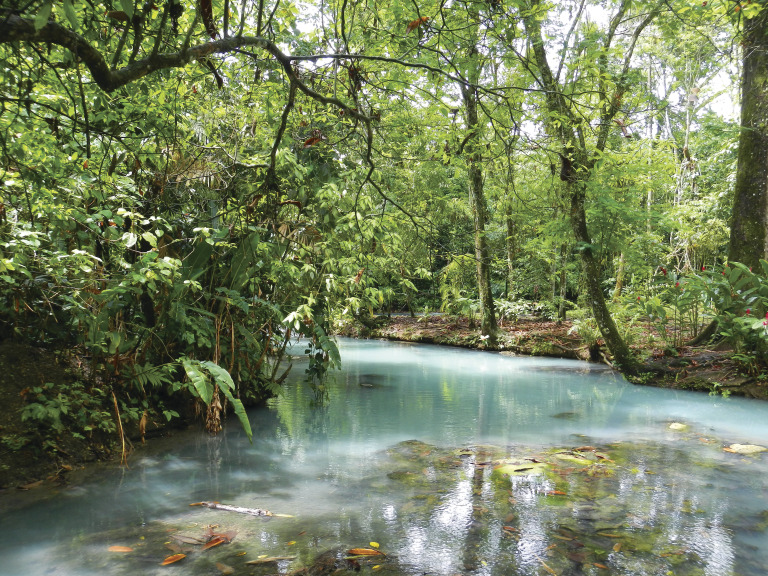ANTHROPOLOGY
Artist’s depiction of M. edwardsi. Image credit: Alex Boersma (artist).
Genome sequencing reveals phylogeny and diet of extinct giant lemur
As recently as 500 years ago, Madagascar was host to diverse, now-extinct megafauna. The island’s tropical and subtropical environments are not conducive to DNA preservation, but Stephanie Marciniak et al. used a high-volume shotgun sequencing approach to reconstruct the nuclear paleogenome of the koala lemur (Megaladapis edwardsi), one of the largest extinct lemurs, from a well-preserved jawbone. The authors used a genome-wide maximum likelihood approach to estimate the phylogenetic placement of M. edwardsi among living lemurs and other primates and found that M. edwardsi is in a sister taxon to Lemuridae but not closely related to Lepilemuridae. The authors also reconstructed possible anatomical and behavioral adaptations of the extinct lemur based on studies of likely gene functions in other species. Convergent genetic similarities with golden snub-nosed monkeys and horses, as well as molar microwear patterns and stable isotope data from prior studies, revealed that the 85-kilogram M. edwardsi was likely adapted to a predominantly leaf-based diet. According to the authors, further improvements in DNA extraction technologies could lead to the recovery of additional nuclear genome sequences of other extinct lemurs and nonlemur primates, many of which also lived in tropical and subtropical environments. — M.H.
NEUROSCIENCE
How monkeys assign economic values to food
In economic choice theory, individuals choose objects by assigning values to them, but how an object’s intrinsic properties shape its value is unclear. Fei-Yang Huang et al. used rhesus monkeys to investigate how biologically critical, intrinsic properties of foods, such as nutrients and sensory qualities, influence their economic values and explain individual food preferences. When monkeys chose between dairy-based, nutrient-defined liquid rewards offered in varying quantities, they consistently preferred fat and sugar to low-nutrient alternatives. Two key food-texture parameters—viscosity and sliding friction—accounted for the monkeys’ fat preferences. The monkeys’ preferences for fats and sugars shifted their daily nutrient balance away from dietary reference points and resembled human overeating in the presence of high-fat and high-sugar foods. The monkeys’ preferences and individual differences were accurately captured by nutrient-value functions, which predicted choices across contexts and suggested that the monkeys assigned subjective values to specific nutrients rather than strictly maximizing energy. The results indicate that biologically critical food components, such as nutrients and textures, influence food’s economic value and individual food preferences. According to the authors, this nutrient-choice paradigm could help unravel the behavioral and neuronal mechanisms underlying food-related choices. — S.R.
ENVIRONMENTAL SCIENCES
Airborne particle samplers at the Marylebone Road station in central London (London Air Quality Network).
Resuspended dust and lead pollution in London
From the late 1980s onward, atmospheric concentrations of lead, a toxic environmental pollutant, in Europe and North America fell as its addition to gasoline was reduced. However, Eléonore Resongles et al. report that lead from historical gasoline use continues to affect air quality in London, England, almost 20 years after its final phaseout as an additive. The authors examined whether remobilization of lead dust deposited from historical gasoline use contributes to airborne lead particles in a contemporary urban environment. To do so, the authors analyzed the lead isotopic ratios of airborne particles collected at a busy street-level location and at building height in London between 2014 and 2018. Comparing the ratios with historical data, the authors found that, after a shift between 1998 and 2001, the isotope ratios remained unchanged over the last decade, suggesting that its sources have not changed. The isotopic ratios match that of road dust and topsoil and do not vary seasonally, indicating that the airborne lead is attributable to resuspension of dust rather than to current coal burning. The authors also modeled historical contributions of leaded gasoline to overall atmospheric lead. According to the authors, gasoline-derived lead remains an important source of lead in the environment and should be considered in abatement measures. — T.H.D.
ECOLOGY
A painted lady butterfly refueling in Morocco before embarking on the long journey to southern Europe. Image credit: Oriol Massana Valeriano.
Painted lady butterfly population fluctuations
Every spring, painted lady butterflies (Vanessa cardui) arrive in southern Europe as part of an annual, multigenerational migration circuit stretching from Scandinavia to sub-Saharan Africa. The size of migrating populations varies, increasing 100-fold in some years, but the reason for the variation is unclear. Gao Hu, Constanti Stefanescu, et al. combined winter and spring environmental data covering critical regions in Africa and Europe, 21 years of butterfly population records from the Mediterranean and northwestern Europe, and atmospheric trajectory simulations along migratory routes to model interannual fluctuations in painted lady breeding cycles. The authors found that a major driver of large painted lady migrations is winter conditions in sub-Saharan West Africa, where unusually high rainfall can produce an abundance of vegetation for emerging larvae during an otherwise dry season. In late winter and early spring, atmospheric conditions allow the butterflies to engage in long-range windborne migration across the Sahara Desert to Northwest Africa, where the next generation of butterflies emerge in March and April before migrating to southern Europe. According to the authors, changing rainfall patterns in sub-Saharan Africa are likely to have unpredictable effects on the Afro-European migratory circuit of painted lady butterflies. — M.H.
EARTH, ATMOSPHERIC, AND PLANETARY SCIENCES
An oblique radar view of Nüwa Campus, the largest block in the Venus lowlands.
Crustal deformation on Venus
In contrast to the system of mobile tectonic plates on Earth, Venus has been assumed to have a globally continuous outer shell, or lithosphere. However, substantial surface deformation is evident on the planet, suggesting a convecting interior. Paul Byrne et al. mapped a set of crustal blocks on Venus termed “campi,” which are distributed globally in the planet’s lowlands. The blocks, the largest of which is approximately the size of Alaska, show little deformation in their interiors but are bounded by belts of deformational features and appear to have moved laterally relative to one another. The campi are analogous to some continental crustal blocks on Earth, and their motions are akin to those of jostling pack ice. Modeling of viscous flow in the planet’s interior revealed that stresses in the crust are consistent with the brittle failure of surface rocks observed in the areas where campi are present. The results support the hypothesis that convection in the planet’s interior is likely responsible for the formation and relative motion of campi. According to the authors, the limited yet global mobility of the Venusian crust offers parallels to Earth’s crust during the Archean Eon, when planetary heat flux was high and the lithosphere was likely thinner than at present. — P.G.
ENVIRONMENTAL SCIENCES
Sulfidic spring near Teapa, Mexico.
Epigenetic inheritance of methylation changes in fish
High concentrations of hydrogen sulfide are toxic to most organisms, but a species of fish native to southern Mexico lives in springs naturally rich in the compound. Joanna Kelley et al. report that Poecilia mexicana collected from springs containing hydrogen sulfide have a particular pattern of DNA methylation and that this epigenetic signature appears to be inherited even in the absence of the compound. The authors compared the DNA methylation patterns of eight Poecilia mexicana individuals isolated from sulfidic springs with those of seven individuals isolated from nonsulfidic springs to determine whether these epigenetic alterations, which can influence gene expression, occur as an adaptation to hydrogen sulfide. The methylated regions of the two groups overlapped by approximately 20%. The authors also compared the methylation patterns of a subsequent generation of each population reared in the laboratory in the absence of high hydrogen sulfide concentrations. The second generation, or grandoffspring, of the hydrogen sulfide–tolerant population maintained an 80% overlap in areas of DNA methylation, even in the absence of hydrogen sulfide. According to the authors, heritable epigenetic mutations maintained in the absence of toxic agents could aid adaptation. — T.H.D.
NEUROSCIENCE
At least in simple video games, actively harmful social norms were the least flexible to modification. Here, a crowd gathers without social distancing in May 2020. Image credit: Shutterstock/qwret.
Harmful social behaviors are the toughest to shift
Posted on June 18, 2021
Amy McDermott
Social norms changed dramatically during the pandemic. Six-foot distancing and mask wearing became de facto rules in some communities, while elsewhere, wearing a mask was seen as an invitation for harassment. A new study in Proceedings of the Royal Society B asks how people learn new social norms and how flexible those norms can be. Using a series of simple video games, author Uri Hertz showed that some norms are easier to change than others. The least flexible behavioral patterns turned out to be those that actively harm others.








